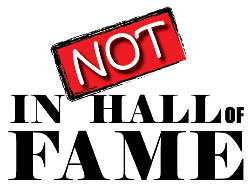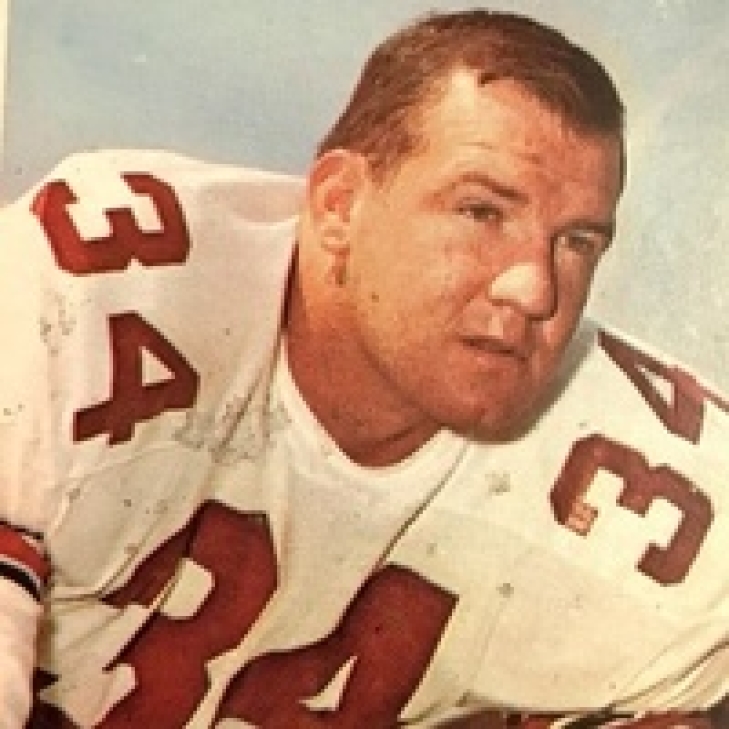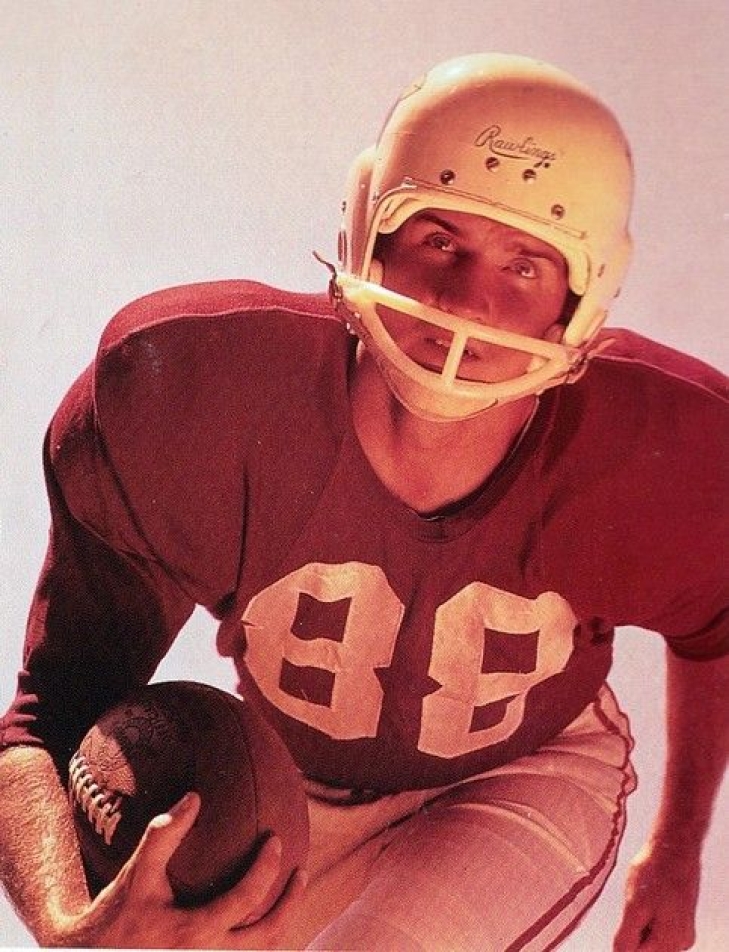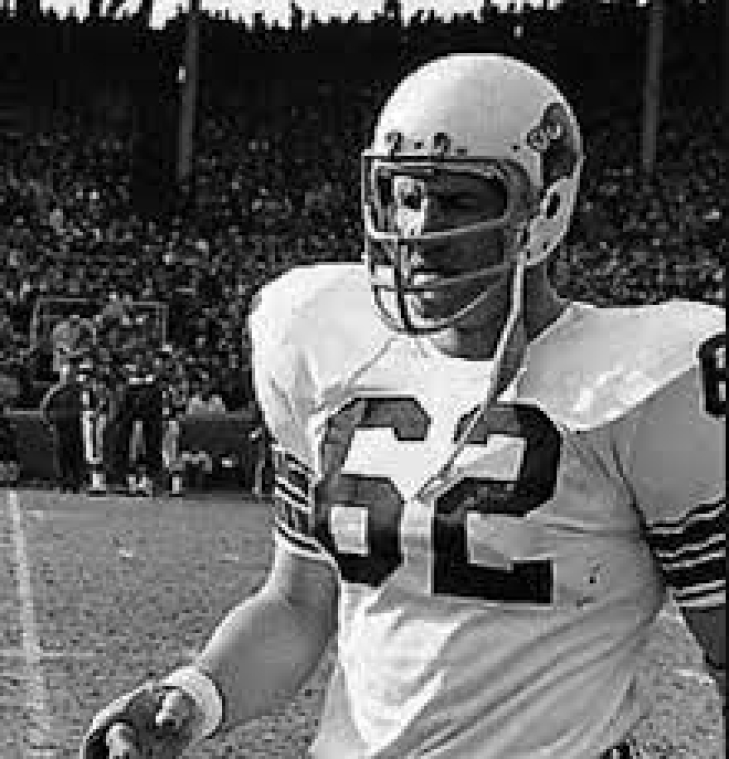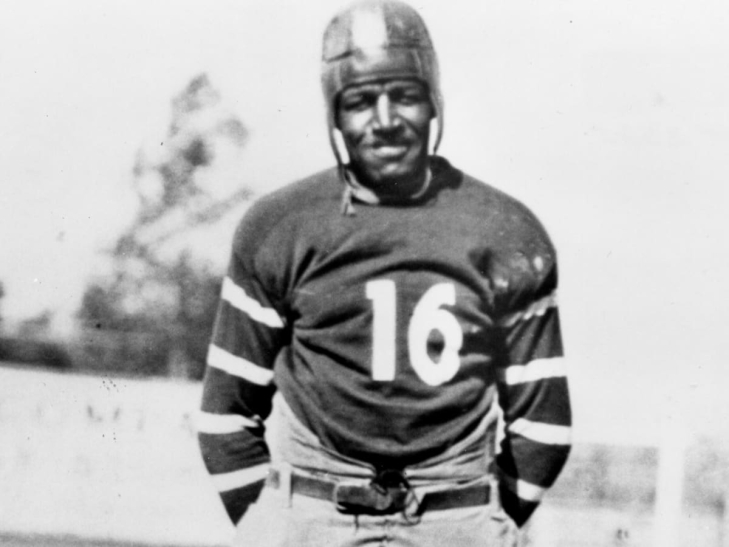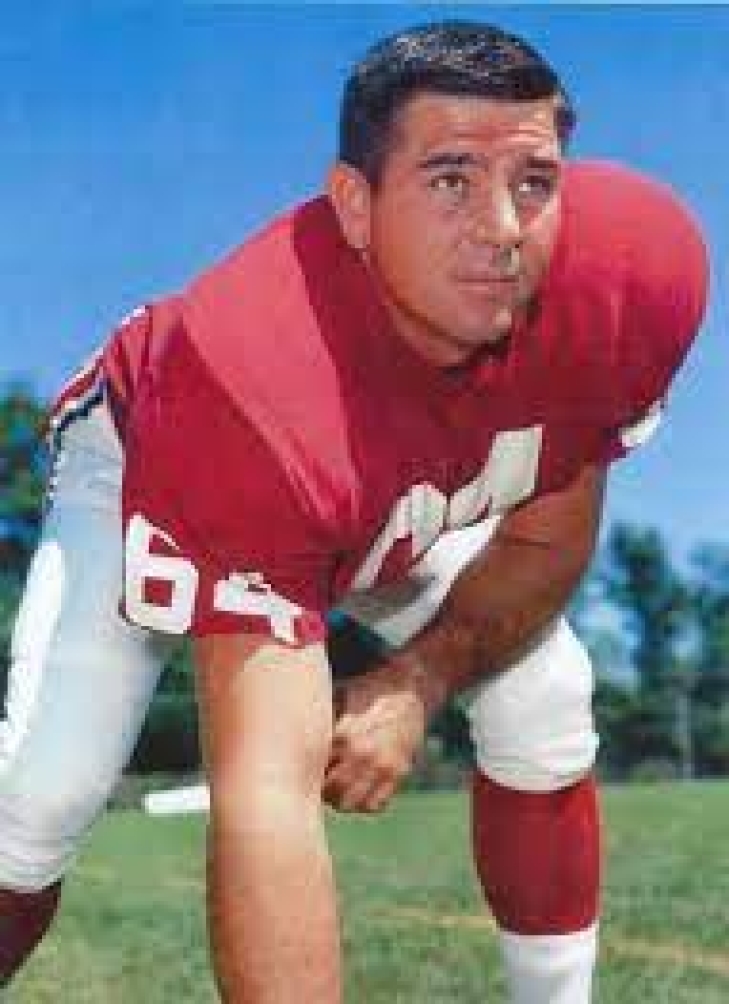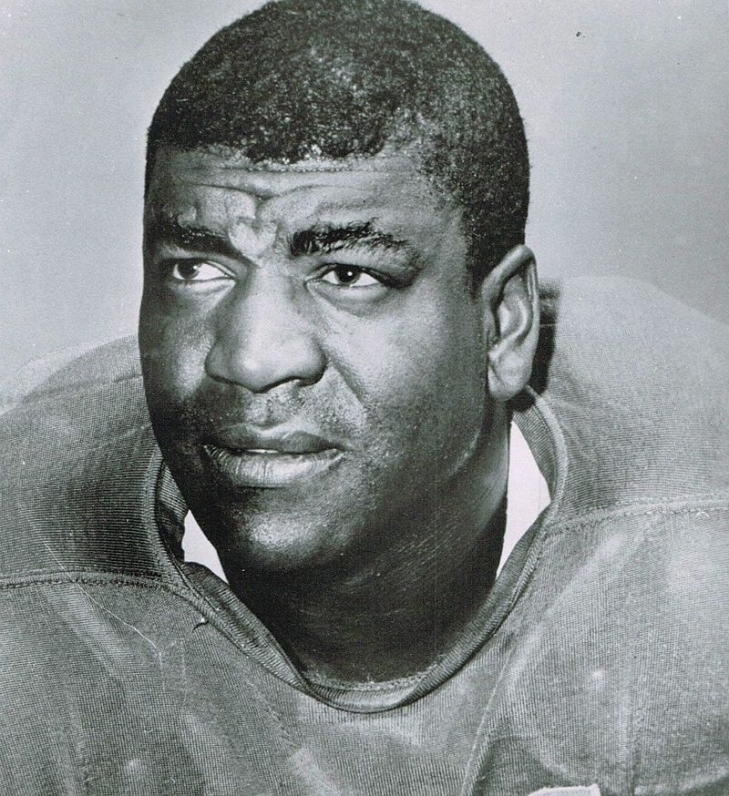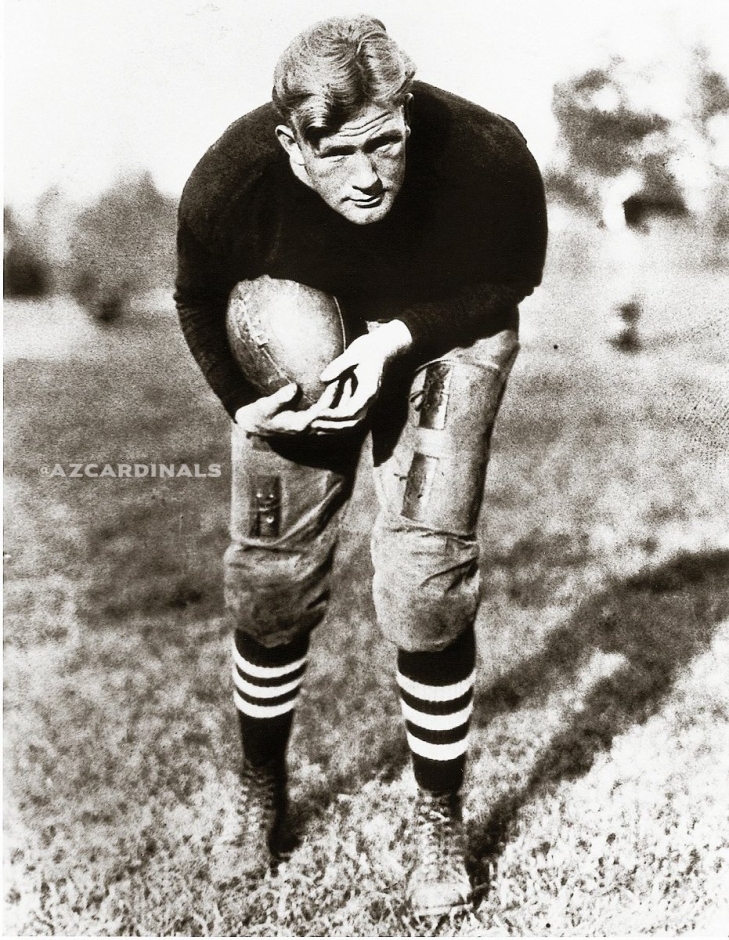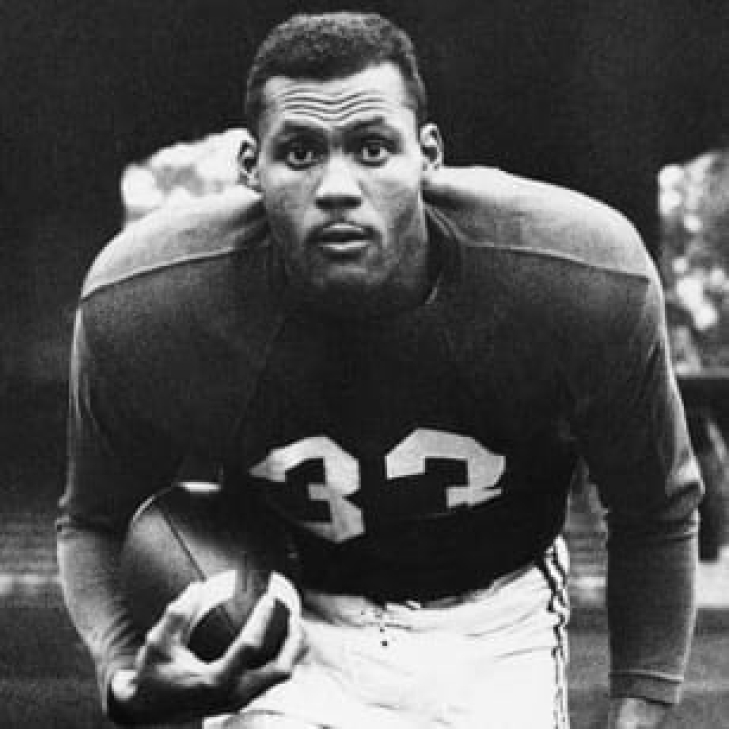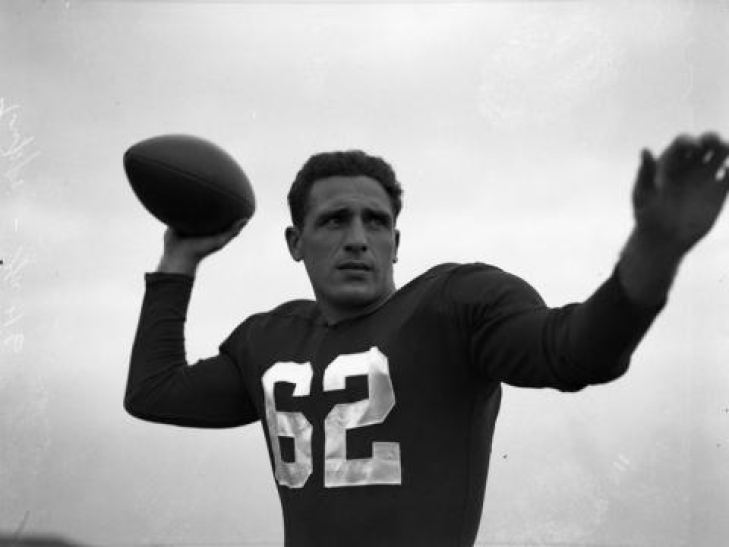50. John David Crow
John David Crow won the 1957 Heisman Trophy, becoming the first player from Texas A&M to win the accolade. The legendary Bear Bryant often referred to Crow as one of the best players he ever had, and that type of hype will propel a player to the number two pick of the Draft, which the Cardinals had and used on the Halfback. Crow was hurt for part of his 1958 rookie season but was able to showcase all his skills in his second year, winning Pro Bowl honors and producing 994 Yards From Scrimmage, though the stat line could never fully encapsulate Crow.
Crow could rush, catch, pass, block, and return, and he could fit in any team's scheme. His best season was his third (1961) and the Cardinal's first in St. Louis, where he rushed for a career-high 1,071 Yards and led the NFL in YFS with 1,533. A second Pro Bowl came to Crow, who was also named a Second Team All-Pro.
Crow could not capitalize on that extraordinary year, as his physical play led to multiple injuries. He only played eight Games in 1961 and was largely ineffective, though a healthier Crow landed his third Pro Bowl on a 17-touchdown Year in 1962. Crow was held to three Games in 1963 and only had 554 Rushing Yards in 1964, and he would leave for San Francisco the following season.
Crow had an even 50 Touchdowns with 5,450 Yards From Scrimmage with the Cardinals.
40. Bill Koman
Bill Koman arrived in Chicago after a trade from the Philadelphia Eagles, and it was as a Cardinal the Linebacker enjoyed his greatest success.
Koman’s first season was in 1959, and as the team relocated to St. Louis, Koman’s profile rose and became one of the team's top Linebackers. A Pro Bowler in 1962 and 1964, Koman was the team's most ferocious tackler and is arguably forgotten as he starred during the franchise's weak decade.
38. Bobby Joe Conrad
We often hear of the "Swiss Army Knife" in the NFL, where players can do many things. That term did not exist when Bobby Joe Conrad played but would have been applied to him had North America known of such a device.
Conrad was drafted by the New York Giants in 1958 but was traded before training camp to the Cardinals. The two-way player from Texas A&M played mainly as a Defensive Back as a rookie, securing four Interceptions, but he was moved to the Halfback position in his second year and then to Flanker in 1962, in year five.
As a Flanker, Conrad had his greatest success, leading the NFL in Receptions in 1963 (73), and was a First Team All-Pro (967 Yards and 10 Touchdowns. Conrad was a Pro Bowler in 1964 and had three 900-yard years, a solid accomplishment for the 1960s. He played for St. Louis until he was released in 1968 and would conclude his career with a season in Dallas.
Conrad compiled 7,633 All-Purpose Yards and 42 Touchdowns and contributed as an occasional Kicker and Punt Returner.
34. Pat Harder
The Second Overall Pick Pat Harder from Wisconsin in 1944, Pat Harder made his first appearance for the Chicago Cardinals in 1946, where he was part of their “Million Dollar Backfield” along with Paul Christman, Charley Trippi, and Marshall Goldberg.
Harder’s tenure with the Cardinals was brief but potent. Living up to the hype, he would help the Chicago Cardinals win the 1947 NFL Championship and went on a three-year streak of First Team All-Pro Selections.
Playing at Fullback and also acting as the Cardinal's Place Kicker, Harder would become the first player in NFL history to exceed 100 Points in three straight years (1947-49). Harder was named the MVP by UPI in 1948, and his overall accomplishments would earn him a membership to the 1940's All-Decade Team.
Harder was traded to the Detroit Lions in 1951 and would win another title there.
32. Sonny Randle
Sonny Randle was a “futures” Draft Pick, meaning that the Chicago Cardinals used their 19th Round Pick in 1958 to select Wide Receiver Sonny Randle, who was still slated to play one more season with Virginia. Randle would make the Cardinals as a rookie, but when the team relocated the next year to St. Louis, he was made a starter and would have the best season of his life.
In 1960, Randle led the NFL in Touchdowns (15) with 893 Receiving Yards. The former Cavalier earned his only First Team All-Pro and began a three-year run of Pro Bowls, punctuated with a career-high 1,158 Yards. Randle did not win a post-season accolade in 1963, though he was solid with 12 TDs and 1,014 Yards. He would gain a fourth Pro Bowl in 1965 (845 Yards and 9 TDs).
Randle left for San Francisco, and compiled 60 Touchdowns and 5,438 Yards with the Cardinals.
31. Dale Meinert
Dale Meinert was initially drafted into the NFL by the Baltimore Colts, but he never played there, instead playing for the Edmonton Eskimos of the Canadian Football League, where he won two Grey Cups. He would return to the United States in 1958, joining the Chicago Cardinals becoming a starting Guard. As the Cardinals relocated to St. Louis in 1960, he was relocated on the gridiron, switching to Middle Linebacker.
Meinert fit better on the defensive side, winning three Pro Bowls and the team MVP in 1961. As the Cardinals were not a league power in the 1960s, Meinert’s contributions are not as celebrated as they should be, but this man was the team's best interior lineman for years.
17. Marshall Goldberg
Marshall Goldberg was a major star at the University of Pittsburgh and would ply his trade well for the Chicago Cardinals. Goldberg did it all in the early 1940s, especially in the 1941 season, where he rushed for 427 Yards, received passes for 313 Yards, and was the top finisher in Kick Return Yards (290), earning him the league lead in All-Purpose Yards (1,236) and a Pro Bowl Selection. He would finish fifth in All-Purpose Yards in 1942. Defensively, he had 19 Interceptions, including a league-lead 7 in 1941.
Like many NFL players, he served his country in World War II, and when he came back, he would rejoin Chicago and help them win the NFL Championship in 1947. Historically speaking, Goldberg was also one of the first Jewish stars of the NFL.
The Cardinals enshrined Goldberg into their Ring of Honor in 2006.
15. Duke Slater
The story of Duke Slater is unique, as very few men can say that they have blazed paths as much as he did.
Slater played his college ball at the University of Iowa, helping them win a share of the National Championship. He signed with the Rock Island Independents following his college career, making him the first African-American Linemen in league history. In 1926, Slater signed with the Chicago Cardinals, making him the first black signee of any team still in existence regarding current NFL teams.
Slater played five years and part of another year for the Cards and was one of their best performers throughout. In every full year, he was with the team, he received a version of an All-Pro and had a seven-year stretch doing so, making him the first Lineman to accomplish that feat. The legendary George Halas described Slater as a one-man line, and praise does not get much better than that.
Following his retirement, there was an unofficial ban on African Americans that stood for nearly 20 years. He continued to break barriers in his personal life, becoming an attorney in 1933 and later a judge. Slater would posthumously enter the Pro Football Hall of Fame in 2020.
14. Ken Gray
Ken Gray was drafted by the Green Bay Packers in 1958 but was unable to make their roster. The Chicago Cardinals took a shot on him, using him at Defensive End as a rookie, but the season after, he was moved to Right Guard, a position he would thrive in.
The Cardinals relocated to St. Louis in 1960, and while Gray was not a star in Chicago, he would become one under the Arches. Gray went to his first Pro Bowl in 1961 and added five more (1963, 1964, 1968, 1967 & 1968) with three All-Pros along the way. Arguably the Cardinals' best Offensive Linemen in the 1960s, he began the next decade with Houston, where he played one year before retiring.
11. Dick "Night Train" Lane
Is there a cooler-sounding name than Dick "Night Train” Lane?
Maybe, but it is not by much.
Nicknamed after the early R&B Instrumental of the same name, Lane was a rarity because he walked on to a professional team (Los Angeles Rams) years after playing in college. Lane asked for (and received) a tryout and subsequently made the team and became a starter as a rookie, where he led the NFL in Interceptions (14). Two years later, he was dealt to the Chicago Cardinals as part of a three-team trade, and the Night Train would be a Cardinal for the next six seasons.
Lane was a dominant Defensive Back for Chicago, collecting four Pro Bowls (1954, 1955, 1956 & 1958) with a First Team All-Pro Selection in 1956. The eventual All-Decade player secured his second Interception Title in '54, and 30 of his 68 picks were as a Cardinal.
The Cardinals might have thought he was done, and they traded him to Detroit before the 1960 Season, where he played six more years.
Lane received the Pro Football Hall of Fame call in 1974 and was named to the NFL 50th, 75th, and 100th Anniversary Teams. In 2006, the Cardinals enshrined Lane in their first Ring of Honor Class.
10. Ernie Nevers
Ernie Nevers was one of the best professional players in Football in 1926 and 1927, starring for the Duluth Eskimos, but it was a different time, and he left the pro ranks to coach at Stanford for a year. Despite saying that he would not return to the gridiron, the lure of the game proved too great, and Nevers joined the Chicago Cardinals in 1929 and had what was the most remarkable offensive season to date.
While official stats on Yardage, Rushing, Passing, and many others are unavailable, we know he was a bona fide touchdown creator. He set the since-tied record of six Rushing Touchdowns in a Game and scored all 40 Points in that contest. Named a Consensus First Team All-Pro, he would be so again over the next two years, though this time, he also served as Chicago's Head Coach.
Nevers retired after the 1931 Season, this time for good, and it kept his health in check as the pounding he took from being the game's top Fullback for three years took its toll.
Despite only playing two years in the 1930s, Nevers was named to the All-Decade Team and was named to the inaugural Pro Football Hall of Fame Class in 1963. Decades later, he was also part of the initial Cardinals Ring of Honor.
9. Ollie Matson
Ollie Matson, a 4x400 Olympic Gold Medalist in the 1952 Helsinki Games, already had plans after achieving huge Track and Field success; he was already the Third Overall Draft Pick by the Chicago Cardinals.
Matson had a strong rookie year with 1,326 All-Purpose Yards, a Pro Bowl, and a First Team All-Pro Selection. He missed 1953 due to military service but was an even better version upon his return, leading the NFL in All-Purpose Yards in 1954 (1,666) and 1956 (1,524) and never had a season with the Cardinals where he had less than 1,200 APY. His trophy case was laden over this period with six Pro Bowls and five First Team All-Pros.
Matson was among the few stars that the Cardinals had in the 50s, but his supporting cast was not great. Chicago only had one winning season while he was there, and the Los Angeles Rams offered seven players and two draft picks for Matson, which they agreed to. None of the players that the Cardinals received made much of a difference, but Matson's skills declined after he moved west. Matson left behind 8,544 All-Purpose Yards and 46 Touchdowns.
An All-Decade Player in the 1950s, Matson entered the Pro Football Hall of Fame in 1972. He was part of the first group when the Cardinals began their Ring of Honor in 2006.
3. Charley Trippi
Charley Trippi was a coveted player from the University of Georgia, and the New York Yankees of the upstart All-American Football Conference thought they had him locked up. The Chicago Cardinals, who drafted him first overall, earned his services when Cardinals owner Charles Bidwell signed him to what was a massive contract at the time, $100,000 over four years.
Trippi was the heart of what would become Chicago's "Million Dollar Backfield," as a rookie in 1947, he would lead the Cardinals to an NFL Championship. Incredibly versatile, Trippi could play any offensive skill position and excelled at rushing, passing, and punting. He played until 1955, finishing his career with the Cardinals and amassing 4,827 Yards From Scrimmage.
Trippi was selected for the 1940s All-Decade Team and the Pro Football Hall of Fame in 1968. The Cardinals selected Trippi for their inaugural Ring of Honor class in 2006.
323. Gaynell Tinsley
There are only three seasons to draw from in the professional career of Gaynell Tinsley, but it was deemed good enough to get him an All-Decade Selection for the 1930s.
281. Buster Ramsey
43. Pat Harder
The 1944 2nd Overall Draft Pick from the University of Wisconsin, Pat Harder, lived up to the hype. He helped the Chicago Cardinals win the 1947 NFL Championship and was selected for the First Team All-Pro for three consecutive years.
Playing at fullback, and also serving as the Cardinal’s place kicker, Harder became the first player in NFL history to exceed 100 points in three straight years (1947-49). Blessed with power and speed, Harder had soft receiving hands and accumulated 3,880 yards from scrimmage over eight seasons, a decent number for his time. Harder was named the MVP by UPI in 1948, and his overall accomplishments earned him a spot on the 1940s All-Decade Team.
Harder's success continued into the 1950s, as he went to the Pro Bowl in 1950. He then joined the Detroit Lions for his final three years, where he helped them win the NFL Championship in both 1952 and 1953 and was a Pro Bowler in the first of those two years.
66. Marshall Goldberg
Marshall Goldberg was a major star at the University of Pittsburgh, and he would ply his trade well for the Chicago Cardinals. Goldberg did it all in the early 1940s, especially in the 1941 season where he rushed for 427 Yards, received passes for 313 Yards and was the top finisher in Kick Return Yards (290), earning him the league lead in All-Purpose Yards (1,236) and a Pro Bowl Selection. He would finish fifth in All-Purpose Yards in 1942.
